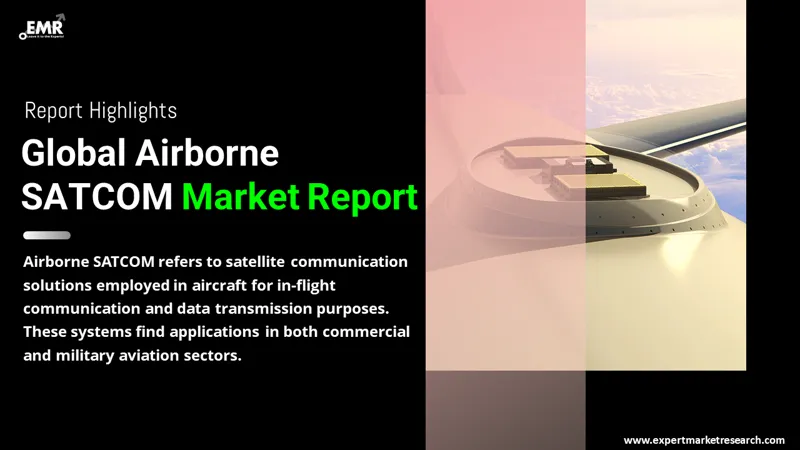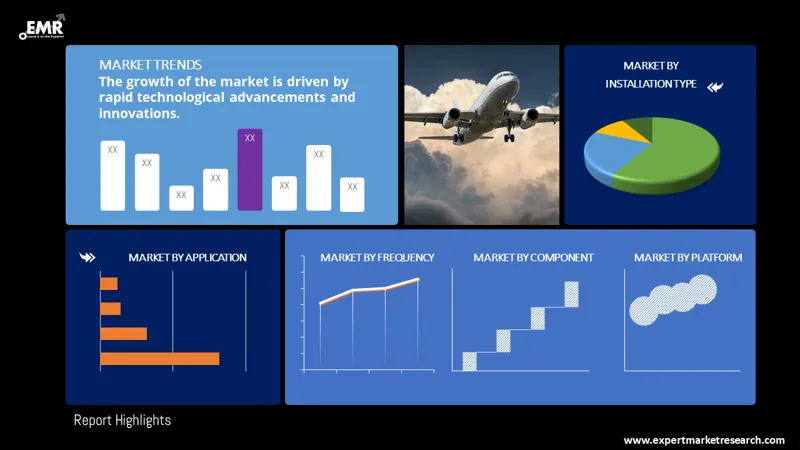
Consumer Insights
Uncover trends and behaviors shaping consumer choices today
Procurement Insights
Optimize your sourcing strategy with key market data
Industry Stats
Stay ahead with the latest trends and market analysis.
The global airborne SATCOM market stood at a value of around USD 5.49 Billion in 2025. The market is further expected to grow at a CAGR of 9.80% in the forecast period of 2026-2035 to attain a value of nearly USD 13.98 Billion by 2035.
Base Year
Historical Period
Forecast Period
Compound Annual Growth Rate
9.8%
Value in USD Billion
2026-2035
*this image is indicative*
Based on application, the government and defence segment is predicted to hold a significant market share in the airborne SATCOM industry. The segment growth can be attributed to the increased expenditure by the governments across the globe in the improvement of the defence sector.

Read more about this report - REQUEST FREE SAMPLE COPY IN PDF
In addition, the growing aircraft fleet as well as the increased demand for on-the-move technologies to aid in defence surveillance and reconnaissance activities are anticipated to aid the market. These factors are expected to contribute to the overall market growth in the forecast period.
North America is predicted to possess a significant share of the airborne SATCOM industry in the forecast period. The market growth in the region can be attributed to the heightened demand for airborne SATCOM solutions in defence and commercial applications. In addition, the rising expenditure by the government in the development of military infrastructure, along with the presence of the leading market players in the region, is predicted to further propel the market growth. Meanwhile, the Asia Pacific region is also projected to witness an increased demand for airborne SATCOM solutions, owing to an increased air passenger traffic in the commercial sector. This is estimated to aid the market growth in the forecast period.
Airborne SATCOM refers to satellite communication solutions that are used in aircraft to enable communication and transmission of data mid-air. These are utilised by both commercial and military aircraft. Airborne SATCOM solutions are essential for military operations, as they allow for a reliable and secure transmission of real-time data.
By component, the market is divided into
On the basis of platform, the market can be segmented into
Based on installation type, the industry can be segregated into
On the basis of frequency, the market can be distributed into
Based on application, the market can be categorised into
Market Breakup by Region

Read more about this report - REQUEST FREE SAMPLE COPY IN PDF
The regional markets for the product include North America, Europe, the Asia Pacific, Latin America, and the Middle East and Africa.
The growing preference of consumers for air transportation is leading to increased passenger traffic. This is propelling the major airline corporations to expand their commercial fleets to meet this rising demand, which, in turn, is aiding the airborne SATCOM industry growth. Major factors influencing this trend include the rising disposable incomes, rapid urbanisation, along with the benefits of convenience and reduced journey time offered by air travel. In addition, the rapid technological advancements to aid in the development of efficient SATCOM solutions are also predicted to propel the market growth in the coming years. For instance, in April 2021, Inmarsat, a leading vendor of mobile satellite communication services, along with Orbit Communication Systems Ltd., a provider of airborne communication solutions, announced that the Orbit GX46 multi-purpose terminal (MPT) has received approval to be used across Inmarsat’s Global Xpress (GX) network. This lightweight terminal offers worldwide connectivity, supporting the military, government, and commercial users worldwide. Such developments are predicted to aid the market growth in the forecast period.
The report gives a detailed analysis of the following key players in the global airborne SATCOM market, covering their competitive landscape, capacity, and latest developments like mergers, acquisitions, and investments, expansions of capacity, and plant turnarounds:
The comprehensive EMR report provides an in-depth assessment of the industry based on the Porter's five forces model and SWOT analysis.
Europe Freeze-Dried Fruit Products Market
Saudi Arabia Electric Motors and Transformers Maintenance Market
Latin America Flexible Packaging Market
Peru Construction Materials Market




*While we strive to always give you current and accurate information, the numbers depicted on the website are indicative and may differ from the actual numbers in the main report. At Expert Market Research, we aim to bring you the latest insights and trends in the market. Using our analyses and forecasts, stakeholders can understand the market dynamics, navigate challenges, and capitalize on opportunities to make data-driven strategic decisions.*
Get in touch with us for a customized solution tailored to your unique requirements and save upto 35%!
In 2025, the global airborne SATCOM market attained a value of nearly USD 5.49 Billion.
The market is projected to grow at a CAGR of 9.80% between 2026 and 2035.
The market is estimated to witness a healthy growth in the forecast period of 2026-2035 to reach USD 13.98 Billion by 2035.
The major drivers of the industry, such as the increased demand in defence applications, rising passenger traffic, increased demand for air transportation services, heightened government investments in the development of defence infrastructure, and the rising investments in the research and development of airborne SATCOM technology by the leading manufacturers, are expected to aid the market growth.
The key market trends guiding the growth of the industry include the rapid technological advancements.
The major regions in the industry are North America, Latin America, the Middle East and Africa, Europe, and the Asia Pacific.
The significant components include SATCOM terminals, transceivers, airborne radio, modems and routers, SATCOM radomes, and others.
The significant platforms include commercial aircraft, military aircraft, business jets, helicopters, and unmanned aerial vehicles.
The significant installation types include new installation and upgradation.
The different frequencies include UHF-band, L-band, S-band, C-band, X-band, Ku-band, and Ka-band.
The major applications include government and defence and commercial.
The major players in the industry are Aselsan A.S., Collins Aerospace, Honeywell International Inc., General Dynamics Corporation, Cobham Aerospace Communications, and others.
Explore our key highlights of the report and gain a concise overview of key findings, trends, and actionable insights that will empower your strategic decisions.
| REPORT FEATURES | DETAILS |
| Base Year | 2025 |
| Historical Period | 2019-2025 |
| Forecast Period | 2026-2035 |
| Scope of the Report |
Historical and Forecast Trends, Industry Drivers and Constraints, Historical and Forecast Market Analysis by Segment:
|
| Breakup by Component |
|
| Breakup by Platform |
|
| Breakup by Installation Type |
|
| Breakup by Frequency |
|
| Breakup by Application |
|
| Breakup by Region |
|
| Market Dynamics |
|
| Competitive Landscape |
|
| Companies Covered |
|
| Report Price and Purchase Option | Explore our purchase options that are best suited to your resources and industry needs. |
| Delivery Format | Delivered as an attached PDF and Excel through email, with an option of receiving an editable PPT, according to the purchase option. |
Datasheet
One User
USD 2,499
USD 2,249
tax inclusive*
Single User License
One User
USD 3,999
USD 3,599
tax inclusive*
Five User License
Five User
USD 4,999
USD 4,249
tax inclusive*
Corporate License
Unlimited Users
USD 5,999
USD 5,099
tax inclusive*
*Please note that the prices mentioned below are starting prices for each bundle type. Kindly contact our team for further details.*
Flash Bundle
Small Business Bundle
Growth Bundle
Enterprise Bundle
*Please note that the prices mentioned below are starting prices for each bundle type. Kindly contact our team for further details.*
Flash Bundle
Number of Reports: 3
20%
tax inclusive*
Small Business Bundle
Number of Reports: 5
25%
tax inclusive*
Growth Bundle
Number of Reports: 8
30%
tax inclusive*
Enterprise Bundle
Number of Reports: 10
35%
tax inclusive*
How To Order

Select License Type
Choose the right license for your needs and access rights.

Click on ‘Buy Now’
Add the report to your cart with one click and proceed to register.

Select Mode of Payment
Choose a payment option for a secure checkout. You will be redirected accordingly.
Gain insights to stay ahead and seize opportunities.

Get insights & trends for a competitive edge.

Track prices with detailed trend reports.

Analyse trade data for supply chain insights.

Leverage cost reports for smart savings

Enhance supply chain with partnerships.

Connect For More Information
Our expert team of analysts will offer full support and resolve any queries regarding the report, before and after the purchase.
Our expert team of analysts will offer full support and resolve any queries regarding the report, before and after the purchase.
We employ meticulous research methods, blending advanced analytics and expert insights to deliver accurate, actionable industry intelligence, staying ahead of competitors.
Our skilled analysts offer unparalleled competitive advantage with detailed insights on current and emerging markets, ensuring your strategic edge.
We offer an in-depth yet simplified presentation of industry insights and analysis to meet your specific requirements effectively.
Share